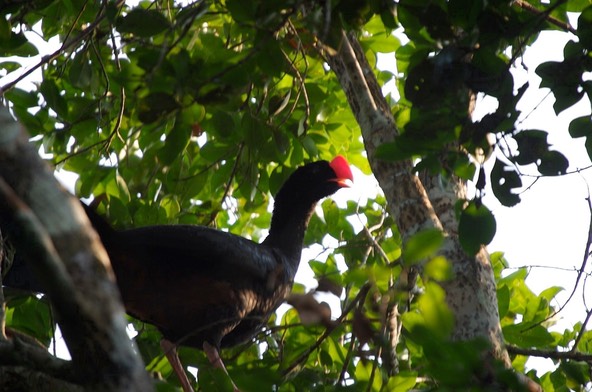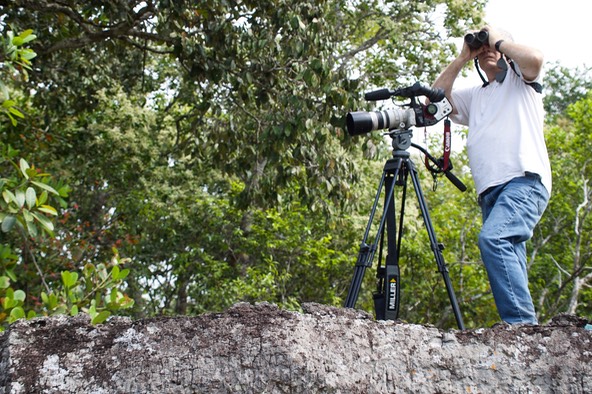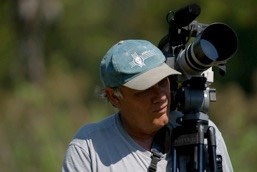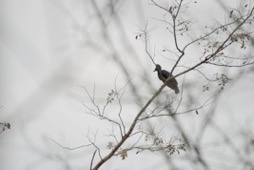My journeys in the southern Amazon are limited to the area around the Cristalino Jungle Lodge in August 2003. The primary feature of the lodge, in addition to being right in the middle of the jungle, is its fantastic canopy tower.
The Brazil portal page for this website includes links to the individual bird species I recorded in this area (see also The Birds of Brazil video portfolio). This is the location where my son and I recorded the first documentation of a Rufous-necked Puffbird at its nest (see the Brazil page on this website). The Birds of Brazil photo gallery includes photographs taken in this area.
Some of my notes from this trip follow the two long-form videos presented below.
Volume 1 of “The Southern Amazon” includes the following bird species; Neotropic Cormorant, Snowy Egret, Capped Heron, Sunbittern, Black Vulture, Hook-billed Kite, Great Black Hawk, Bat Falcon, Red-throated Piping-Guan, Razor-billed Curassow, Spix’s Guan, Blue-and-Yellow Macaw, Chestnut-fronted Macaw, Golden-winged Parakeet, White-eyed Parakeet, Blue-winged Parrotlet, Painted Parakeet, Crimson-bellied Parakeet, Blue-headed Parrot, White-bellied Parrot, Squirrel Cuckoo, Wood Stork, Great Potoo, Blackish Nightjar, Black-throated Mango, Collared Trogon, Ringed Kingfisher, Amazon Kingfisher, Green Kingfisher, Paradise Jacamar, Black-fronted Nunbird, Swallow-wing, Black-girdled Barbet, Red-necked Aracari, Lineated Woodpecker, Yellow-tufted Woodpecker, Spangled Cotinga, Bare-necked Fruitcrow, and Amazonian Umbrellabird.
Volume 2 of “ The Southern Amazon” includes the following bird species; Long-tailed Tyrant, Great Kiskadee, Piratic Flycatcher, Rusty-margined Flycatcher, Fork-tailed Flycatcher, Tropical Kingbird, Dusky-chested Flycatcher, White-winged Swallow, Southern Rough-winged Swallow, White-banded Swallow, Donacobius, Thrush-like Wren, Crested Oropendola, Yellow-rumped Cacique, Blue Dacnis, Masked Tanager, Palm Tanager, Blue-gray Tanager, and Magpie Tanager. It also includes video of the following mammal species; Brazilian Tapir, White-lined Sac-winged Bat (this is probably a Proboscis Bat, Rhynchonycteris naso), White-nosed Bearded Saki Monkey, and White-bellied Spider Monkey.
Notes From This Trip
Canopy Towers are some of the most exotic places in the tropics. Not because of what they are but where they put you - in the tree tops. Cristalino has a fifty meter tower and Jon and I spent many a sunny day at its top. From the tower it is possible to see for miles in any direction, across the top of the jungle. Or if you wish, you can focus a few feet away as White-bellied Parrot (photo below) eat berries in the top of a tree.
Notes from the tower: "It is still early, the air is pleasantly warm, but will be hotter by 9:30, and water will taste very good then. The little wasps are just beginning to show up and gather water from the little pools of dew on the metal floor. Soon they will begin buzzing around and stinging. In the end, it is the stinging, not the heat, which will drive me down from the tower.
For now, everything is wonderful - a flock of Parakeets (probably Painted Parakeets) is flying in and out of the green canyons formed by the difference in tree heights. A bit of mist lifts and shifts from here to there.
The sea of green is punctuated occasionally by a splash of super-saturated color which is a blooming tree.
The stairs seem to go on for a long time when you climb to the top, but not nearly as long when you walk down and enter the darkness of the jungle floor. From the jungle floor, the tower suddenly appears, amazing that something so big can hide in the jungle.
The only human sounds here are footsteps on the stairs and the mechanical squeak of the pulleys as the cameras and tripods are raised to, or lowered from, the top of the tower."
I mentioned my Rufous-necked Puffbird video above. During our visit, the nest of a Rufous-necked Puffbird had been found upriver. There was no documentation of this species at a nest. The Lodge management had a plan to thoroughly document the nest at the end of the nesting period, before the high water of the wet. We discussed the possibility of documenting the bird at the nest. The bird rarely visited the nest, however, and there was concern about disturbing that limited schedule.
After a day of discussions with the staff we concluded that we could use a Hi-8 camera we have with us to try to document the adult bird’s visit to the nest. We had used this camera in very low light and night-time photography in the past. (We have some interesting video of scorpions shot in pitch dark in Costa Rica.)
Over the next several days we set the camera up near the nest with battery packs and long tapes and let it run. We were able to document the bird at the nest on two occasions.
Our tape of this effort captures the tedium and the excitement, the boat rides, the walks through the dark jungle, and the joy. And I hope that it captures the pride I felt as my sixteen year-old son organized and led the effort; of how he kept it going when everyone else was getting discouraged. It has to be the high point of that trip.

A cursory review of the material from this trip revealed some interesting photographs, including Amazonian Umbrellabird (above) and this one of a Razor-billed Curassow taken by my son in the Amazon near Alta Floresta, Brazil. We had been boating upriver on the way to tape Hoatzin when Jorge suddenly said “Curassow”, pointed to his nose, said “rojo”, and headed for shore. My heartbeat doubled as Jonathan and I readied camera equipment. We scrambled up the bank and into the thick undergrowth, moving as quickly and quietly as we could -- we saw the bird within moments but getting a clear shot proved to be problematic.
The following day, just as dawn was breaking we were in the boat heading upriver, the air was cool and moist and the steam hung heavy on the river as we wound our way deeper into the jungle. At a rapid on the river the boats pulled in for a portage (others were heading farther upriver to see Hoatzin) and we disembarked to venture up a track into the jungle. At first we passed through disturbed land which had been put into various crops, then through a transition zone of second growth, and then into the jungle -- with tall Brazil Nut trees and some slow birding. We had a great deal of fun on this day, it was a slow and peaceful effort with just enough excitement to keep things interesting.
As dusk approached we walked back through the disturbed areas to meet the boat coming down river. The sun was going down quickly -- in this land of equal day and night the period of dusk and dawn is remarkably short and shots like ones shown here can be difficult.

We arrived back at Cristallino Lodge just after sunset and had a wonderful dinner which included piranha soup and their great deserts.
I am not sure that “birding” is what I do. I take video and photographs of birds and if I don’t get the image it doesn’t count. The equipment is heavy, it’s hard to carry around, and it’s an anchor in so many ways. It also opens a whole different world, a different way of seeing.
Many years ago I purchased my first macro lens for my SLR and suddenly I was seeing things I had never seen before, usually smaller things but also things which I was seeing differently because of the framing.

I also purchased a super-8 movie camera with a big lens at that time and fell in love with motion, but found the restrictions of the format terribly burdensome. I only returned to motion pictures when the first portable VHS cameras came out -- that was fun but lugging the tape deck around (especially in the type of environment I relish) was difficult. We all wondered if there would ever be a time when everything was integrated.
I still groan with the weight and bulk of the equipment but it now has such fantastic capabilities, delivers such beautiful images that all of the “carry-on luggage” hassles and the worry about being “ripped off” is nothing in comparison.

Can videotaping and birding co-exist? Yes, I think so - but you have to set the parameters. When I was a lister, I would travel hundreds of miles for a new state bird. But as a videographer, I spend more time with individuals and with individual species. I am more interested in behavior, in getting an excellent sighting. It takes more time, species counts go down, and it is more tiring. But they are not incompatible, as these photos show, you need to have the bin’s to determine if you have a chance at the bird of interest.
When you photograph or videotape birds, the eyes must be in focus. It does not matter if everything else in the image is in focus, if the eyes are not in focus the impression left with the viewer is that it isn’t right, that it doesn’t accurately depict nature, that it is not true. Works of art are often not clearly focused in a physical sense, they are representative, they are less than precise physically so that they can capture the metaphysical truth. But whether or not it accurately depicts nature - the eye must be in focus.
Once a lovely woman asked me “what is true?”, actually she asked several people, but being egocentric I am sure it was really addressed to me. The answer is easy, if I had a picture of her eyes I would place them on this site for the world to understand truth. The clarity of focus, of knowledge, of intellect, of beauty. Nature is true, eyes are true, if we loose nature, how will we know the truth -- there are only so many enchanting eyes in the world.

While at Cristalino we ventured down a side trail to a site called the “Secret Garden”. A open area in the jungle dominated by stone outcrops. It is a location which has been a traditional favorite because it gives good views into the jungle and pole benches have been built to accommodate the guests. We are early in the season, however, and the benches are still covered in vines from the off-season. The jungle encroaches everywhere when it is given a remote chance. Facilities often have to be cleared each year of vines and young trees. This location is relatively immune because of the bedrock but even here human-made structures are quickly engulfed.
It is a location where you can sit and wait for an Amazonian Umbrellabird (photo right) to show up - it happened to us, I’m sure it could happen to you too!!
It is August the weather was nice but the word on the trail was that we should expect some afternoon rains in the next day or so. Even so off in search of a manakin and we were soon deep into primary forest. The trees there often have buttresses - for stability in the wind, I know this because of my readings.
We heard it coming, it had a roar like a locomotive. We could not see anything, the jungle is very thick, but we could hear, hear that it was not coming terribly fast, but it was very loud. Through a hole in the jungle we could see the tops of trees start to whip around savagely. Then the wind was upon us, branches and leaves were falling, the sound was incredible, the top half of the jungle was a nightmare of movement, on the ground there was barely any wind, just falling debris, big debris.
We stood there for a long time, there was no place for cover, all we could do was look upward, watching for falling limbs. It was very scary. It would have been less so if my son was not with me. But there we stood, learning by experience why the trees had buttresses.

During the next week we have had a rain or two but that did not keep us inside. My son and I decided to canoe down the Rio Cristalino, despite the threat of an afternoon rain -- we had worked hard at the “secret garden” in the morning and the thought of being on the water in the afternoon heat was very appealing.
We started off and made leisurely time as we paddled close to the shore, taking photographs of birds like the Donacobius in the photo below . We had a long way to go, and had a pretty good idea of where to pull in (a small beach on the right just before the Rio Teles Pires).
We saw the wind coming, the top of the jungle was whipping around, and then we saw the rain - a sheet of rain. We covered the equipment with our rain gear and paddled as hard as we could. We almost make it. We were soaked by the time we reached the beach.
We made a small platform for the equipment and covered it with rain gear and the upside down canoe. We sat on the beach in the pouring rain. We were not in a good mood.
The sound of the outboard was welcome, we could hear it for quite awhile before we saw Jorge coming to rescue us and haul us back to the lodge. By that time, he had been around us for awhile and knew our priorities. His boat had a covered area in front and as he glided it up on the beach he pointed to the equipment. We grabbed the equipment and handed it over and it was quickly stowed in a “dry” place. Then we hooked a tow rope to our canoe and headed off up river. We rain pelting our faces hard as we zipped upstream.